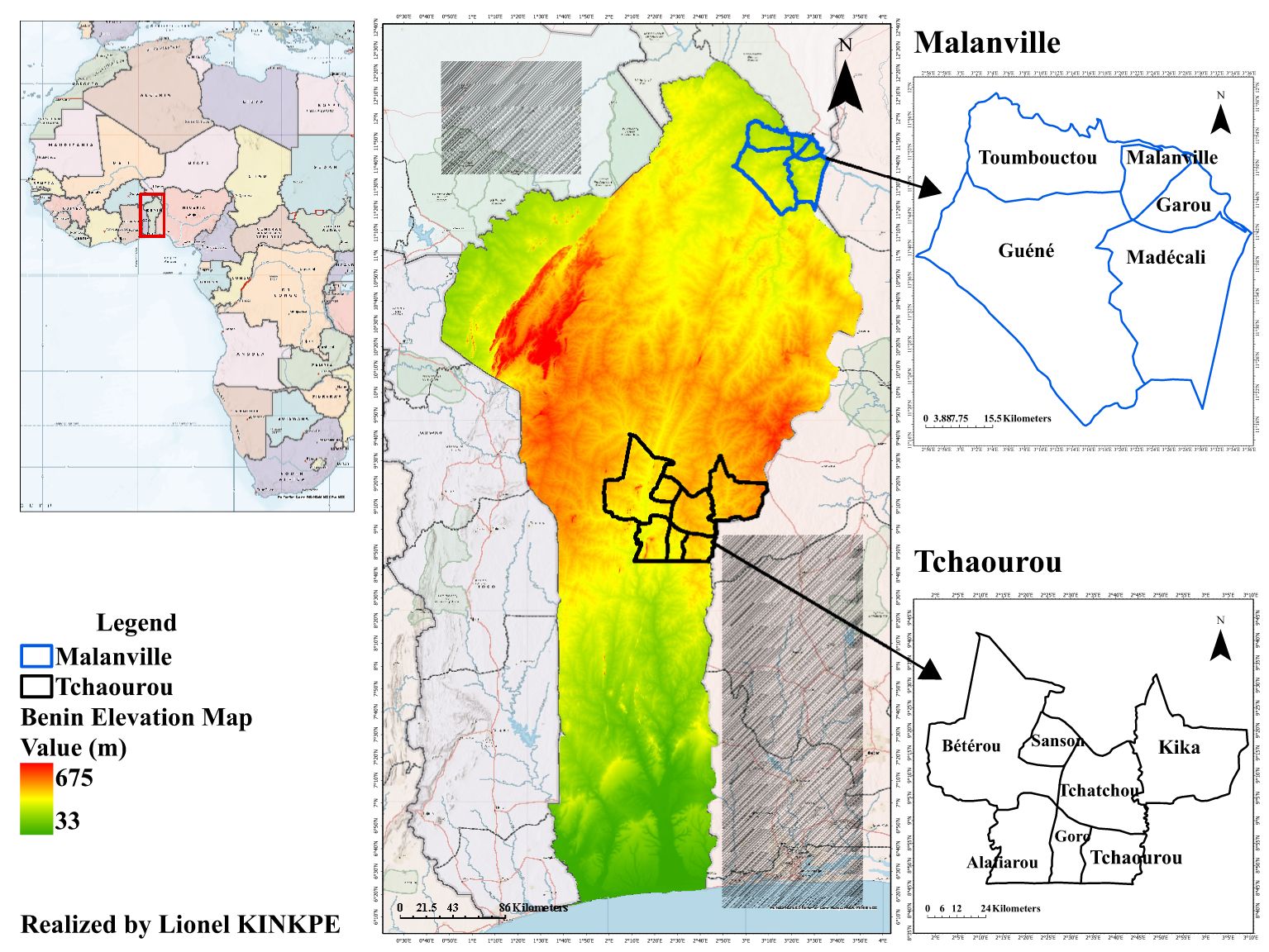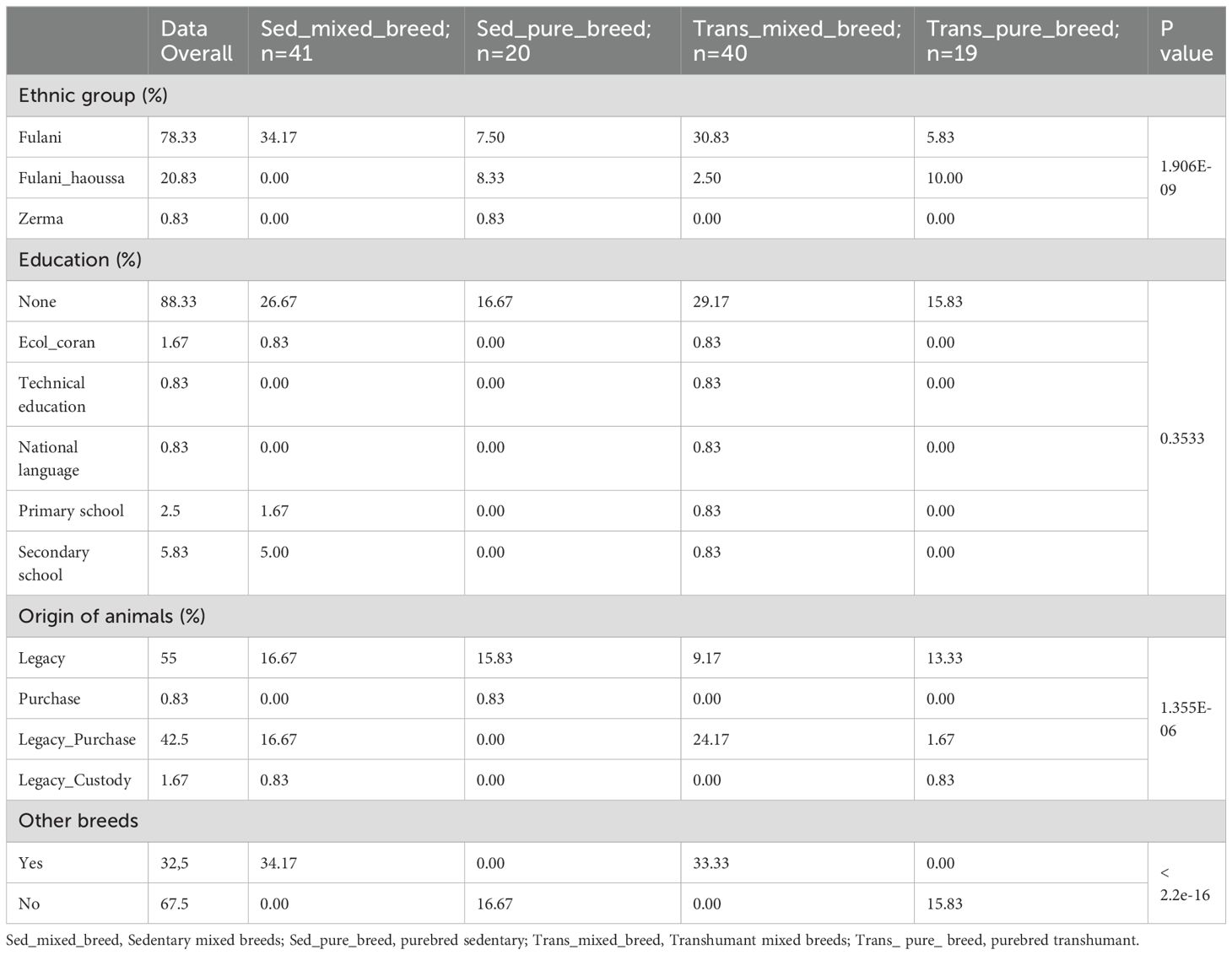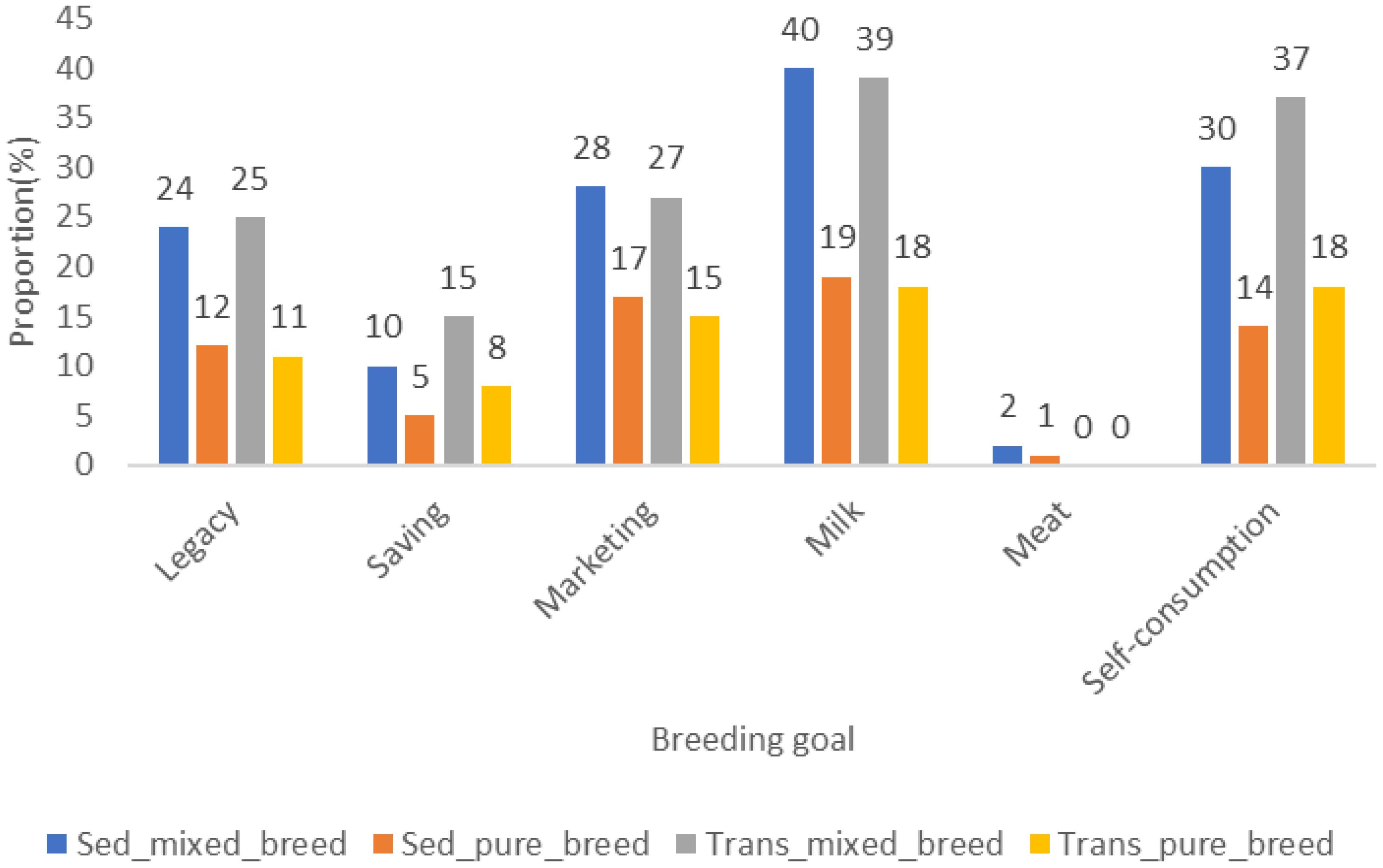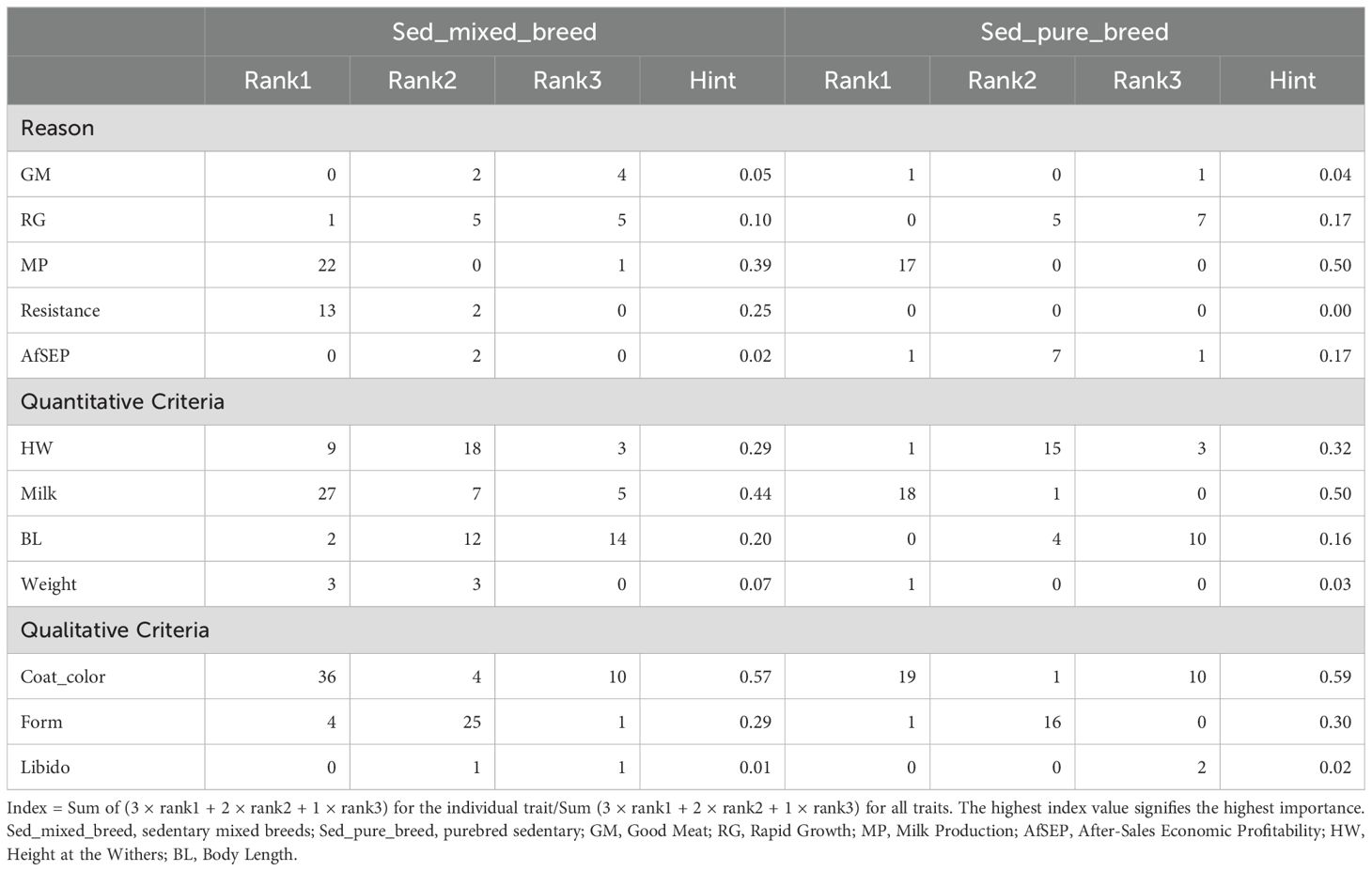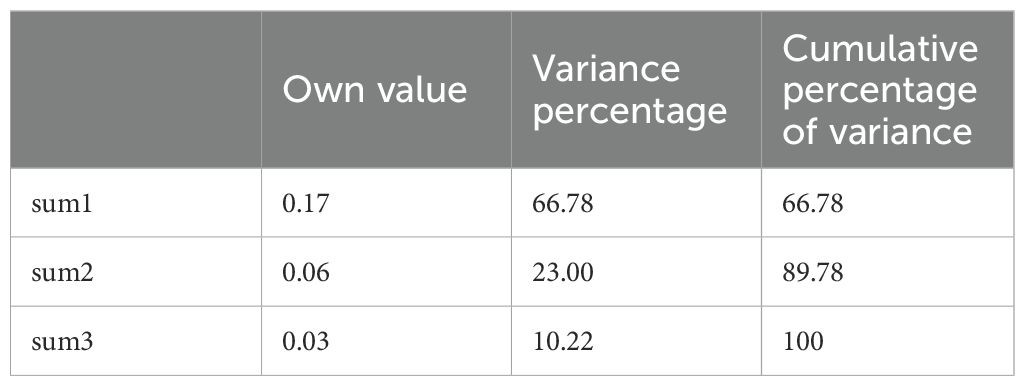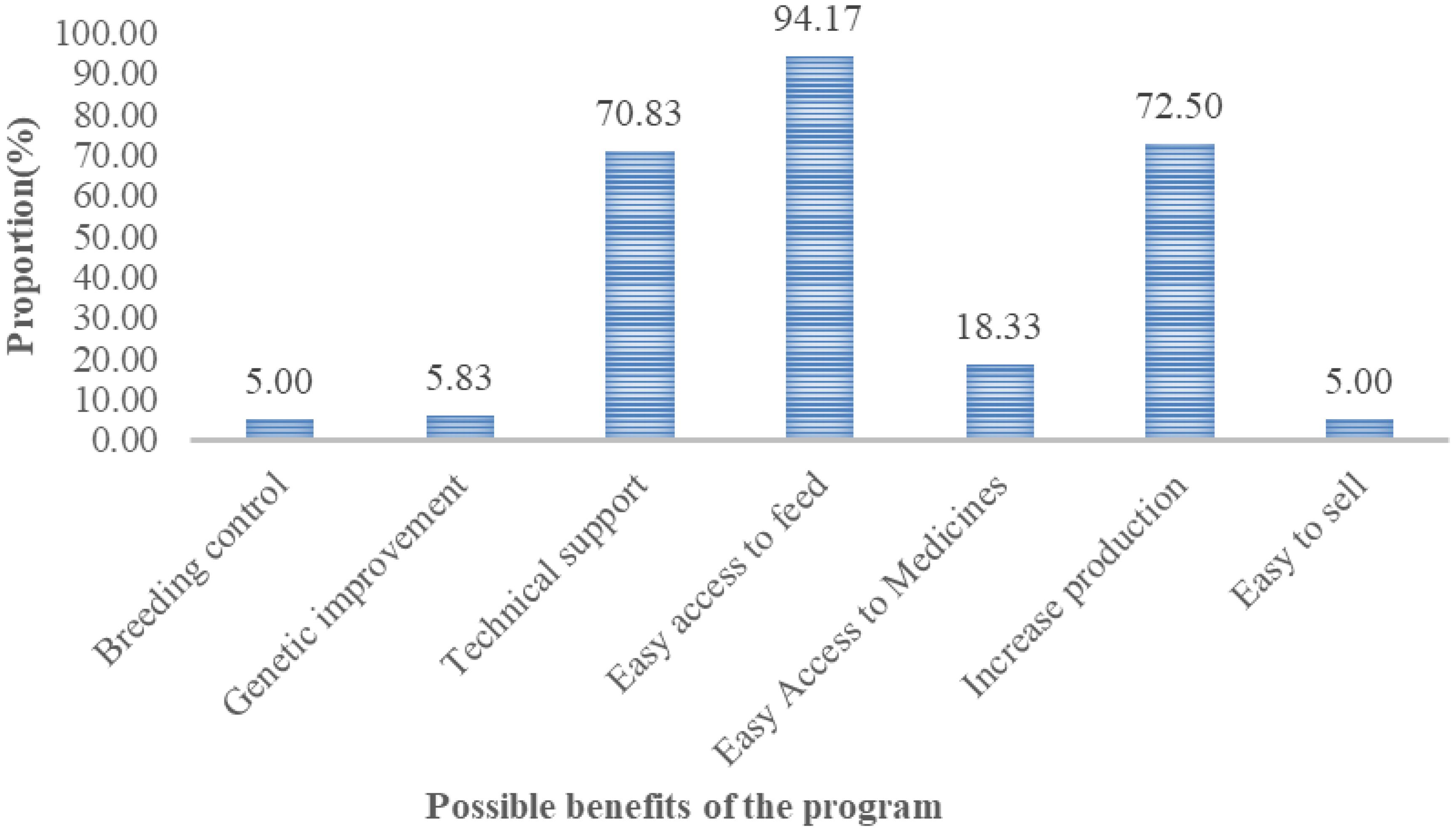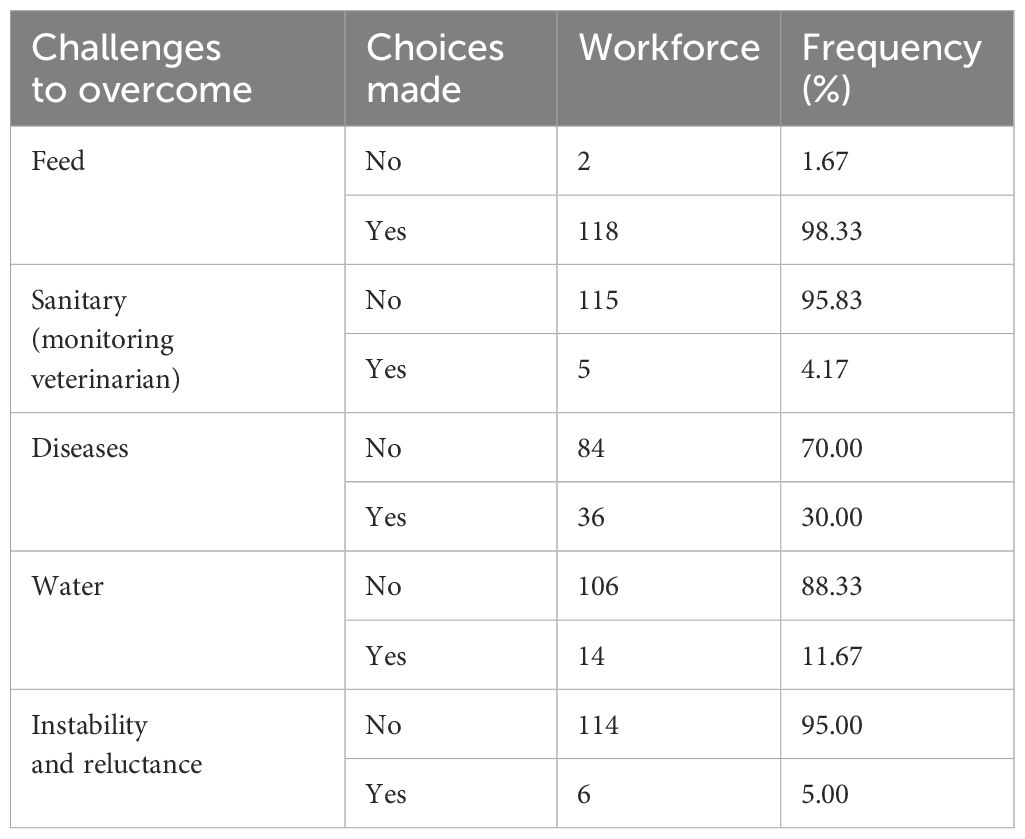- 1Laboratory of Ecology, Health and Animal Production (LESPA), Faculty of Agronomy, University of Parakou, Parakou, Benin
- 2Animal Production and Health Laboratory, Department of Nuclear Applications, Joint Food and Agriculture Organization/International Atomic Energy Agency (FAO/IAEA) Division of Nuclear Techniques in Food and Agriculture, Vienna, Austria
- 3The Roslin Institute and Royal (Dick) School of Veterinary Studies, University of Edinburgh, Edinburgh, United Kingdom
- 4Centre for Tropical Livestock Genetics and Health (CTLGH), Roslin Institute, University of Edinburgh, Edinburgh, United Kingdom
- 5Animal Breeding Genetics and Reproduction, Northwest Agriculture and Forestry University, Yangling, China
Understanding farmers’ breeding systems and preferred traits is crucial for establishing effective genetic improvement programs. This study investigated Gudali cattle breed selection, breeding objectives, and selection criteria in North-east Benin (Malanville and Tchaourou). We surveyed 120 Gudali cattle farmers using a structured questionnaire and conducted hierarchical clustering using R software. We identified the distribution of farmers based on herd composition and production systems. Farmers were grouped into four classes: Sedentary Purebreds (16.67%), Transhumant Purebreds (33.33%), Sedentary Mixed Breeds (34.17%), and Transhumant Mixed Breeds (15.83%), with average Gudali herd sizes ranging from 23.68 to 90.11 heads depending on the system. The overall average herd size was 42.67 ± 6.00 heads. The majority of farmers owned different breeds, including Borgou (26.67%), Yakana (26.67%), and Azawak (7.5%), with only 32.5% having Gudali only herds. Farmers chose Gudali cattle for their milk production, good growth and market value, with 96.67% prioritizing milk production. The main selection criterion was coat color in all breeding systems with respective indices of 0.59; 0.57; 0.54 and 0.47 respectively for sedentary purebred; sedentary mixed breed; transhumant purebred and transhumant mixed breed systems. Most mixed breed farmers (55.84%) cross Gudali with local breeds for better dairy performance. While only 3.33% of farmers were aware of community-based breeding programs (CBBP), there was strong interest (95%) in participating. Potential challenges such as access to feed and disease management were reported. The proposed mitigation strategies include establishing pasture areas and strengthening collaboration among stakeholders. Implementing CBBP programs by incorporating farmers’ preferences and practices, could sustainably improve Gudali cattle productivity and resilience in Benin.
Introduction
Livestock plays important role in the economy of developing countries. Its contribution to GDP was estimated to about 44% for West African countries (Kamuanga et al., 2008). The West African region has more than 76 million heads of cattle, 279 million small ruminants, 564 million poultry, which makes it a quintessential breeding area par excellence (FAOSTAT, 2023). Livestock sector also represents a source of income and nutrition for the resourceless populations. For millions of people, it mainly represents insurance for postharvest risks, especially during lean periods (Lawal et al., 2018). In addition to its food and economic importance, livestock also has cultural importance and reflects the social status of the farmer.
Cattle breeding provides a large part of human food through dairy and meat production, which indirectly constitutes a source of savings for farmers (Chettoui and Boughena, 2020). However, Soukehal (2013) shows that livestock farming is subject to a multitude of constraints which hinder the development of dairy and meat production.
Traditional production systems, characterized by low productivity, dominate African livestock farming (Bello Abdul Sobour et al., 2021). In Benin, various national initiatives to improve milk production through crossbreeding local breeds with exotic ones have largely been unsuccessful (Doko et al., 2012; Youssao, 2015). The Zebu breed, particularly Gudali, offers a promising avenue for improving local cattle performance due to its robustness and productivity (Alladaye and Youssao, 2017; Assani, 2013; Boya et al., 2022). Despite its potential, research on the Gudali breed in Benin is limited, primarily focusing on morphological traits and performance (Assani et al., 2015; Assani and Alkoiret, 2014; Houessou et al., 2019). Located in Northeast Benin, the Gudali cattle are well adapted to harsh environmental conditions. However, there is a lack of studies on farmers’ preferred traits, production objectives, and selection criteria. The first step in successful implementation of any breeding program is to characterize production systems and to identify farmer’s specific preferred traits in relation to breeding objectives (Ouédraogo et al., 2020). Following the profound socio-economic changes that have affected both Gudali natural biotope and its genetic diversity, it is essential to evaluate the farmers’ preferred traits, selection criteria of the breeding stock as well as the indigenous knowledge used for the breed improvement and conservation.
This study is unprecedented in its focus on the Gudali cattle breed in North-eastern Benin, addressing a significant gap in the literature by examining farmers’ preferences and breeding strategies. The aims of this study were therefore to characterize the breeding practices, selection criteria and farmer’s preferred traits for Gudali cattle breed in the North-Eastern part of Benin Republic in order to design community-based breeding strategies.
Materials and methods
Study area
Data collection took place in the municipalities of Malanville (GPS coordinates of 11° 51’ 47.9988’’ North and 3° 23’ 3.2892’’ East) and Tchaourou (GPS coordinates of 8° 53’ 11.4” North, 2° 35’ 51.1” East) in North-East Benin (Figure 1). The choice of the two municipalities is not only due to their large number of cattle herds but also due to their diversity in farming systems (Assani, 2013). In addition, livestock farming occupies a prominent place in the development of these municipalities. They have the main centers of development of the livestock sector.
Methodology
One hundred and twenty (120) cattle farmers with a total of 5144 heads of Gudali cattle breed were investigated from June to December 2022 using a questionnaire (semi-structured interview). The cattle farmers having at least one Gudali cattle breed in their herds were selected according to their availability and willingness to participate in the study. Snowball sampling was used to identify additional herders in the two municipalities (Assani, 2013; Dossa and Vanvanhossou, 2016; Worogo et al., 2023). The contents of the questionnaire included the reasons for the choice of the breed, the selection criteria they use, and their preferred selection traits in order of priority. The preferred selection traits were grouped by category for data analysis. The questionnaire was administered in the farmer’s mother tongue with the help of translators.
The survey data was processed using an Excel spreadsheet, and corrected before being imported into the R version 4.2.0 software (R Core Team, 2020). An ascending hierarchical classification based on the characteristics of the farms on the most significant Factor Correspondence Analysis (FCA) components made it possible to identify and characterize the farms. The variables ‘‘main production’’, ‘‘breed preference, and reasons for the choice of farmers’’ were taken into account. For the ranking of trait preferences for bull breeds, the number of times and the order in which the trait was mentioned by individual cattle owners were considered to weigh the traits (ratio scale rating). The index of ranking I = Sum (3×rank1 + 2×rank2 + 1×rank3) for the individual trait/Sum (3×rank1 + 2×rank2 + 1×rank3) for the global traits was computed (Elias et al., 2018; Getachew et al., 2018; Zewdu et al., 2018) was calculated. The final trait ranking was made based on the traits rated on the ratio scale.
Results
Characteristics of breeding practices in Gudali cattle
The investigated cattle owners were not fairly distributed in the districts of the municipalities. In Malanville, they were mainly present in Garou and Madecali districts and in Tchaourou Center and Tchatchou districts in the municipality of Tchaourou. Not all the cattle owners interviewed were purely Gudali cattle farmers. The majority of them own other breeds of cattle such as Borgou (26.67%); Yakana (26.67%); Azawak (7.5%). The distribution of stock farmers according to herd composition (pure or mixed breeds) and the production system (Sedentary or Transhumant) allowed to group them in four classes: Sedentary Purebreds (16.67%); Transhumant Purebred (33.33%); Sedentary mixed breeds (34.17%) and Transhumant mixed breeds (15.83%). Only 32.5% (39 out of 120) had 100% Gudali herds. The average number of Gudali cattle in the investigated herds was 24.27 ± 3.63 and 23.68 ± 5.05 heads respectively for sedentary and transhumant mixed breeds. The farmers were from various ethnic groups, with a large majority of the Fulani ethnic group (78.33%), followed by the Fulani-Haoussa ethnic group (20.83%), originally from Nigeria (Table 1). The average herd size per household was 74.50 ± 9.4 for sedentary purebreds and 90.11 ± 30.34 for transhumant purebreds (Table 2).
The average age of the investigated farmers was 42 ± 1.16 years. This shows that the farmers have a certain experience in the field of breeding which they may pass on from generation to generation for the sustainability of the activity. Regarding education, a high percentage of the cattle owners (88.33%) had no formal education, highlighting the traditional nature of the cattle breeding practices. Few had attended primary school or coranic school, while technical education and secondary school attendance were minimal across the groups. In terms of animal origin, a significant proportion of cattle owners relied on legacy animals (55%), either inherited from their families or a combination of legacy and purchased animals (42.5%). Only a small portion depended solely on purchased animals. The group differences in animal origin were statistically significant, indicating varying practices in how herds are built and maintained among the different production systems.
Farmer’s reasons for choosing Gudali breed
The reasons reported by respondents for raising Gudali cattle breed varied across production systems and are presented in Figure 2. Most farmers in sedentary and transhumant systems raise the breed for dairy production. The milk is sold to generate daily income or is used for self-consumption to meet protein needs of households. In both production systems, some farmers believe they remain breeders in order to leave a legacy to the next generation. Thus, heritage (preserved heritage) is also one of the reasons why farmers keep the breed. For them, preserving traditions and knowledge associated with livestock farming is essential to ensure the sustainability of livestock systems and the well-being of rural communities. Most of the investigated farmers mentioned having Gudali cattle in other to sell calves, culled cows or even seriously ill animals. Cash for household needs including school fees as well as illness of a family member were also reported among the reasons for keeping Gudali cattle breed. Apart from the above reasons, breeders chose the Gudali cattle breed because of its milk production capacity, rapid growth, good carcass characteristics as well as good market value.
Selection criteria and husbandry practices
The selection criteria used by farmers are presented in Tables 3 and 4. There is a difference between selection criteria and their importance from one production system to another. The coat color was the most important criterion for the selection of breeding stock by farmers, followed by the milk yield. These farmers most often had animals with white coats because they believe that white color protects the animals against the attack of certain disease vectors. The format and height at the withers were the most important criteria in the sedentary mixed breeds production system. The Height at Withers was the only reported criterion in purebred sedentary animals’ system (Table 3) while the animal conformation was the most reported criteria in transhumant production system (Table 4).
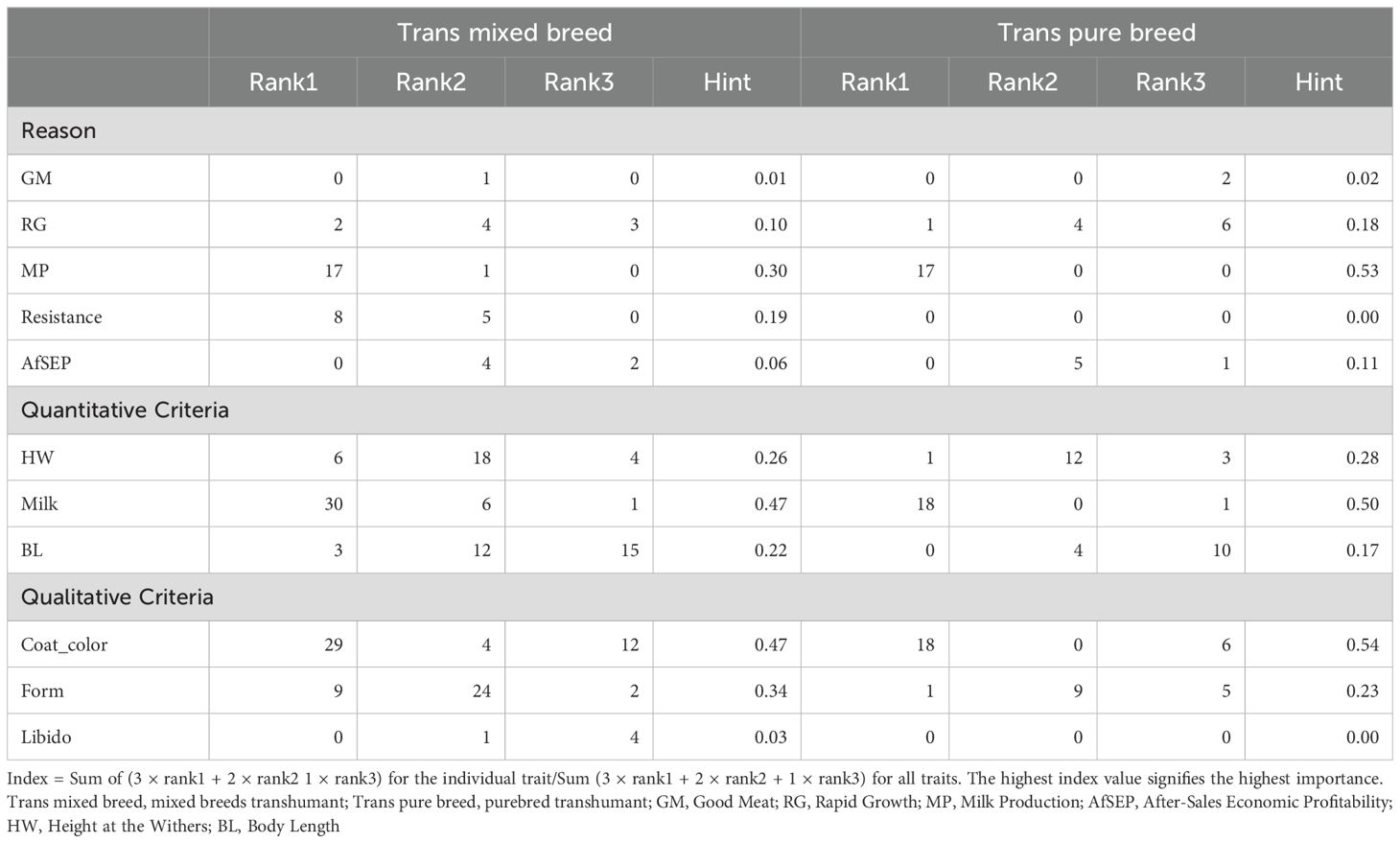
Table 4. Index of selection criteria used by transhumant cattle farmers in the study area (continued).
The survey revealed that farmers are used to keep a particular breed as a sire in their herd because they have inherited them (Heritage choice) and want to pass them on to the future generations. The libido and the state of the testicles in the male parents and the teats in the females were important criteria in the two breeding systems.
Main production of farmers
Table 5 presents the results of the Factorial Correspondence Analysis (FCA) on the matrix of variables of the main production of farmers. On the three dimensions that explain the distribution of the main production of the farmers by district, the first 2 axes of the analysis explain 89.78% of the total information. The factorial plane formed by these two axes is largely sufficient to explain the total variability of the data. Therefore, the variability associated with other components may be least significant.
The projection (Figure 3) makes it possible to have two groups. The first group (66.67% of the samples) made up of pure-bred transhumant and sedentary farmers and mixed-race sedentary; it includes three districts (Alafiarou, Madécali and Tchaourou center) of the study area. The second group (33.33% of the sample) involved the rest of the arrondissements, which according to this figure are mixed-race transhumant herders. The figure shows that in the first group milk, meat and savings are the main productions of these farmers. On the other hand, prestige breeding is more observed in the second group.
Breed improvement and conservation methods
Four methods were reported by farmers: selection; castration; crossbreeding and conservation of the local breed (Table 6). Selection was practiced by around 15% of the farmers in each mode of breeding. The reasons for the selection by these farmers are among others the maintenance of the dairy performance of the cows; growth performance of young animals and maintaining the reproductive/production performance of breeding males. Castration is a method practiced by a minority of the investigated farmers. This method is more practiced by sedentary people of mixed breeds (5.83%) and transhumant people of mixed breeds (4.17%). The main reasons for castration were to control mating, improve docility and avoid fighting. The practice of castration and the reasons for castration varied significantly from one production system to another. Crossbreeding is practiced by only sedentary and transhumant mixed breeds (55.84%) and justifies the reason for having different breeds in the herds. Crossbreeding is mainly practiced to improve the dairy performance of their herd and to benefit from transfer of disease resistance to the offsprings. Conservation of the pure local breed was practiced by almost all the farmers. The goal of this practice is most often ‘‘ not to lose the breed’’ so that it is transmitted from generation to generation.
Farmer’s level of knowledge on community based breeding programs
Among the investigated farmers, only 3.33% of them had at least heard of CBBPs, but none of them had been involved in a CBBP (Table 7). However, half of the farmers already belonged to a livestock farmers’ association (Table 7). Three associations were listed by these farmers: UCOPER (Communal Union of Ruminant farmers and Professional), UDOPER (Departmental Union of Ruminant farmers and Professional) and APESS (Association for the Promotion of Livestock in the Sahel and Savannah). They are in these associations for different reasons. The majority adhere to UCOPER and UDOPER to benefit from veterinary care, technical supervision and practical breeding advice among others advantages. They belong to APESS for the purpose of defending their interests during conflicts and also to benefit from other advantages. Their Motto is ‘‘Stronger Together Forever’’. The remaining farmers do not belong to any associations for various reasons including mobility, lack of information, membership requirement which they consider restrictive, lack of trust and reluctance.
Potential benefits of CBBP and farmers’ preferred traits to improve
Figures 4 and 5 show the possible benefits and traits of interest to be considered in a CBBP for Gudali cattle breed according to farmers. Increased production and technical support, and easy access to feed resources were the reported possible advantages of such a program. Their important traits of interest to be included in the CBBP included increased milk yield (94.17%), growth traits (64.17%), diseases resilience (40%) and prolificacy (35%).
Potential challenges in a Gudali CBBP and mitigation strategies
Tables 8 and 9 show respectively the potential challenges that could limit Gudali CBBP program as well as mitigation strategies according to farmers. As potential challenges, access to feed was mentioned by 98.33% of farmers followed by diseases (30%). The suggested mitigation strategies suggested by farmers were the establishment and installation of artificial pasture areas and routes reserved for cattle movements and managed by communities. All farmers mentioned that collaboration between various stakeholders of the CBBP program and existing farmer associations will be critical. Furthermore, all investigated farmers expressed high interest to be involved in a potential Gudali CBBP program in their region.
Discussion
The results show important variation in breeding practices, selection criteria, farmer’s preferred traits of Gudali cattle breed in the North-Eastern part of Benin Republic. Furthermore, we investigated farmer’s knowledge on a community-based breeding program, their interest to establish one for Gudali breed as well as the potential challenges and mitigation approaches. These results highlight broad points for discussion in the sections below.
Production objectives, selection criteria and breed preference
The main production objective of the farmers in the study area was milk. This milk was mainly intended for self-consumption and sales. Indeed, milk is mainly used for domestic consumption in Fulani households, but the surplus is sold on local markets, providing the main source of income for the women who mostly manage the milking (Hampshire, 2006). The sale of milk surplus by farmers has also been reported in Burkina Faso (Dossa and Vanvanhossou, 2016; Roessler, 2019) and use cattle manure to fertilize crops, earning money if necessary (Roessler, 2019). Similar studies on small ruminants and cattle have reported keeping animals for cash income, savings, wealth and social reasons (Duguma, 2010; Guangul, 2014). According to Dossa and Vanvanhossou (2016), milking was the main objective of Somba cattle farmers, although these animals were also used for agricultural work in the fields. According to Soro et al. (2015), Baoulé cattle are mainly raised in the “ Lobi Country “ in Côte d’Ivoire for ritual ceremonies, gifts and as security against the vicissitudes of life. In Mali, on the other hand, the main production objective was domestic meat consumption and social functions (Traoré et al., 2017). In southwest Burkina Faso, animals are raised for a variety of functions (Ouédraogo et al., 2020) as in West Africa with a difference in the order of importance (Ejlertsen et al., 2013; Traoré et al., 2017). Meat production constitutes the main objective of the majority of Lagune cattle breeders in Benin, in contrast to the breeding practices observed in our study. This choice aligns with the low milk production of the Lagune breed, making milking not economically viable (Adoligbe et al., 2020). The same authors emphasize, however, that some Lagune breeders are motivated by a deep passion for these animals and their particular temperament.
This study revealed that coat color and milk production are the most important criteria used in selection of Gudali cattle breed. Similarly, milk production, coat color and patterns were important aesthetic reasons for selection of Azawak cows in Niger (Belli et al., 2008). In addition, the majority of small-scale dairy farmers in Niamey (Niger) preferred the Azawak breed because of its milk performance (Belli et al., 2008). Likewise, small-scale dairy farmers in Jimma town (Ethiopia) preferred Holstein x indigenous zebu cows because of their high milk yield (Duguma and Janssens, 2016). In contrast, in southwestern Burkina Faso, milk productivity apart from cash income was the main trait (objective) of production (Ouédraogo et al., 2020). Moreover, in West Africa Tano et al. (2003) found that disease resistance was one of the most important traits among cattle keepers. For Roessler (2019), dairy performance was an important factor in the selection and trait preferences of cattle breeds in Ouagadougou (Burkina Faso).
Health traits are important but difficult to breed for in low-input systems with little pedigree record (Wuletaw et al., 2006). Breeders in this study reported that white coat color helps deter flies and reduces the risk of infestation, reflecting practical environmental adaptations. This aligns with studies showing the advantages of white coat color in tropical environments, such as improved heat dissipation and higher milk yields in Holstein cows (Anzures-Olvera et al., 2019; Maia et al., 2005; Theusme et al., 2023). However, it is important to note that while white coat color is prioritized in certain systems, it is not universally preferred across all production environments, as genetic, economic, and environmental considerations vary (Hall, 2012).
Thus, the selection of coat color, particularly white, in Gudali cattle is driven not only by aesthetic preference but also by practical environmental benefits, underscoring the complex nature of breeding decisions across different regions and systems. Criteria related to morphological traits such as horn shape and sheath were ranked low in our study. Our results corroborate the findings of previous studies showing their insignificance in Ethiopian Sheko cattle and in Central Africa Ankole cattle (Elias et al., 2018; Ndumu et al., 2008; and Wurzinger et al., 2006). These animal beauty traits may not be taken into account in community breeding programs with the communities concerned according to the results of studies carried out by Ouédraogo et al., 2020 in Burkina Faso. In addition, udders and testicles are reported as additional selection criteria for male and female farmers (Tadesse et al., 2005; Zewdu et al., 2018).
Cattle producers’ breed and trait preferences and selection criteria were consistent with their primary production goals. The Gudali breed was particularly valued for its higher milk yield, large size/good growth rate, docility and higher market value (Roessler, 2019). Due to its good adaptation to local production conditions, the local Zebu Fulani was preferred over other breeds in a similar study conducted in Burkina Faso by (Roessler, 2019). Cattle farmers also considered this breed to be heirloom, meaning that farmers’ attachment to this breed is from generation to generation. Body size/growth, breast milk production and behavioral traits were the most important farmers’ preferred traits (ratio scale assessment) reported for selection of local Fulani zebu bulls (Roessler, 2019).
Other breeds of cattle such as Yakana, M’bororo, Borgou, and Azawak are preferred by some herders because of their disease resistance and relatively low feed requirements. These reasons are similar to those highlighted by Belli et al. (2008) on the Fulani zebu breed.
Animal performance enhancement techniques
The results of this study highlighted four methods (selection, castration, crossbreeding and conservation of the local breed) used by farmers to improve performance of their herds. Castration is a method observed more frequently in mixed sedentary and transhumant breeds. The main reasons for castration are to control mating, improve docility and prevent fighting. A study conducted in Burkina Faso by Mopaté et al. (2014) reported the systematic castration of males of other breeds mated with Baoulé cattle to avoid crossbreeding, which was not the case in our study. This practice varies significantly from one farmer to another.
The goals of some farmers in crossing other breeds with Gudali cattle, were to increase size, milk yield and growth performance. According to Traoré et al. (2015); Ahozonlin et al. (2019) and Ouédraogo et al. (2020), this traditional practice of breeders plays a crucial role in achieving their production objectives by strengthening the disease resistance of the offspring. The study by Orou Yorou et al. (2014) also highlighted crossbreeding and selection as methods for improving animal performance in Parakou.
Relevance of setting up a community-based selection program for Gudali cattle
Among the cattle farmers investigated, only 4 farmers or 3.33% (Table 7) had at least heard of CBBP but none of them benefited from any training in this regard. Furthermore, out of a total of 120 respondents, only 6 or 5% of these farmers consider that they do not belong to the program because of their instability (transhumance) or either their reluctance (Table 6) . At the end of this study, 114 (95%) farmers surveyed were available and agreed to the implementation of the CBBP program. Like Goudali cattle breeders in the study area, Somba cattle owners express a keen interest in participating in well-designed improvement programs, aimed at both optimizing production and preserving this breed of cattle native (Dossa and Vanvanhossou, 2016).
Community-based breeding (CBB) has a long history and has been used as an agricultural research tool since the 1970s (Omore et al., 2008). It is a breeding method that improves the performance of native breeds or varieties, while maintaining their adaptability and genetic diversity. It uses simple, low-cost methods (Haile et al., 2010) and strives to take into account farmers’ needs, opinions, decisions and active participation (Haile et al., 2011; Mueller et al., 2015). The CBBP has been successfully implemented on small ruminants (sheep, goats) and llamas using smallholders’ indigenous genetic resources in Latin American countries (Mueller et al., 2002; Wurzinger et al., 2013). This has also been successfully implemented in eastern and southern Africa in sheep and goats (Haile et al., 2014; Haile et al., 2023; Mueller et al., 2023). Digesa (2023) indicated improvements in the growth characteristics of sheep since the introduction of the selection program in Ethiopia. However, due to the widespread use of industrial breeding stock and the availability of assisted reproduction technologies, CBPP for cattle are very rare. All the cattle farmers surveyed were ready to be involved in a potential CBPP for Gudali cattle offering opportunities for sustainable genetic improvement and conservation of the breed in Benin.
Potential challenges to overcome in the implementation of CBBP for Gudali breeding
The implementation of a Community-Based Breeding Program (CBBP) for the Gudali breed may face several challenges that need to be carefully addressed. One of the key issues reported in CBBP is the definition of clear breeding objectives that align with the needs and priorities of the farmers involved (Ragot et al., 2018). Successful CBBPs depend on the willingness of communities to participate actively, and ensuring this engagement is essential for the program’s success. It is important to assess community readiness and interest in collaborating on shared breeding goals, such as the exchange of breeding bulls and other resources (Zoma-Traoré et al., 2021).
Another significant challenge is the establishment of supportive institutions for critical CBBP components such as animal identification, data collection, and genetic evaluation (Mueller et al., 2015). Without these institutional supports, it becomes difficult to track breeding progress and ensure the preservation of genetic diversity. As highlighted in this investigation, farmers in remote areas often have limited access to veterinary services and technical assistance, which intensifies the difficulty of implementing these programs. The shortage of veterinary agents and lack of access to disease management tools in isolated regions can further reduce the effectiveness of the program (Mulatu et al., 2021).
Additionally, issues related to feed availability and grazing land due to environmental constraints have been reported as potential significant challenge for Gudali breeders. The absence of sufficient grazing areas often leads to poor nutrition, affecting the productivity and health of the livestock. Furthermore, as noted by Mueller et al. (2015), smallholder farmers often struggle with financial and material limitations that make it difficult to implement conventional breeding programs. The same challenges apply to CBBP initiatives if they are not adequately supported by local institutions and governments.
Although farmers often recognize the potential benefits of joining breeders’ associations—such as increased income (Laborde et al., 2020) and greater sustainability of breeding programs (Gutu et al., 2015; Wollny, 2003) they are generally more hesitant when it comes to the practice of bull sharing. A study in Burkina Faso demonstrated that farmers who were members of associations or cooperatives had a more positive attitude towards the conservation of local cattle breeds than those who were not (Mopaté et al., 2014).
Based on these insights, we recommend the establishment of formally registered and recognized breeders’ associations specifically for Gudali cattle. These organizations should be built on existing social structures to encourage greater acceptance among farmers (Wurzinger et al., 2011). Membership should include clearly defined rules, rights, and obligations (Wollny, 2003). Additionally, discussions within the association should emphasize the broader community benefits of bull sharing, such as improved herd genetics and economic advantages, to mitigate any negative attitudes.
Given the varying attitudes towards bull sharing and farmer collaboration, particularly among “Transhumant Fulani” farmers observed in this study, it is important to maintain continuous dialogue among stakeholders. This dialogue should explore collaborative options for preserving and improving Gudali cattle breeds. A successful community-based breeding intervention must rely on the active commitment of livestock keepers, while also respecting the decision of those who choose to opt out.
Finally, the lack of market access and low market value of Gudali livestock pose additional economic barriers. Inadequate market infrastructure may discourage farmers from investing in improved breeding practices, as they may not see immediate financial benefits. This underscores the importance of integrating market development with breeding programs to ensure that the economic incentives for participating farmers are clear and substantial. Addressing these challenges (defining breeding objectives, fostering community participation, establishing institutional support, and improving market access) will be crucial for the successful implementation of a CBBP for Gudali breeding. These elements are essential to ensure both the sustainability of the program and the long-term preservation and improvement of the Gudali breed.
Mitigation strategies in potential CBBP for Gudali breeding
Several recommendations have been made by several authors for successful implementation of CBBP (Bhuiyan et al., 2017; Haile et al., 2023; Ouédraogo et al., 2021). Thus, the success of any community-based selection program for Gudali cattle breed in the study environment should take into account the various challenges cited above. To this end, a participatory breeding program involving communities in the selection of breeding animals based on desired characteristics and local knowledge can lead to improved productivity and adaptation to local conditions (Getachew et al., 2018; Haile et al., 2023; Kosgey and Okeyo, 2007). This could involve establishing community selection groups and providing training on selection criteria and selection techniques (Mueller et al., 2015).
Regular capacity building through training for farmers on topics such as animal health, record keeping and breeding techniques can enable them to manage their herds more effectively and make informed breeding decisions (Boersema et al., 2023; Rhone et al., 2008). Empowering communities to collect and manage data about their livestock, such as performance records and pedigree information, can provide valuable information for selection and breeding decisions (Mueller et al., 2015). As mentioned byAynalem et al. (2023), initiatives integrating income-generating activities into CBBP projects, such as ecotourism or the development of value-added products, can incentivize communities to invest in sustainable breeding practices and conserve the Gudali breed. Establishing partnerships with research institutes, government agencies and NGOs can facilitate access to resources, expertise and technology, and promote the sharing of knowledge and best practices for Gudali breeding (Sterling et al., 2017).
Conclusion
This study highlighted for the first time the production objectives, farmers’ preferred traits and selection methods in four Gudali cattle production systems in North-East Benin. Transhumant and sedentary herders prefer Gudali cattle breed because of its good growth, higher milk yield and excellent market value. Despite the strong interest in community-based breeding programs (CBBP), farmers’ knowledge of these programs remains limited, emphasizing the need for increased awareness, training, and capacity building. To ensure the sustainability of Gudali breeding, it is crucial to focus on participatory breeding programs, improving genetic diversity, and enhancing management practices through research and development. Additionally, promoting supportive policies and advocacy for community-based breeding programs, fostering strong collaborations between communities, stakeholders, and research institutions, along with supportive policies for CBBP, will be key to driving the long-term success of Gudali breeding initiatives. Furthermore, the study focusing on a specific region may limit its broader applicability. Further studies will be needed in other regions and production systems in the country.
Data availability statement
The raw data supporting the conclusions of this article will be made available by the authors, without undue reservation.
Author contributions
LZ: Writing – original draft, Conceptualization, Data curation, Formal Analysis, Investigation, Methodology, Resources, Software, Visualization. IH: Conceptualization, Funding acquisition, Project administration, Supervision, Validation, Writing – review & editing. AA: Conceptualization, Funding acquisition, Project administration, Supervision, Validation, Writing – review & editing. HW: Formal Analysis, Software, Validation, Visualization, Writing – review & editing. LK: Software, Writing – review & editing. KP: Formal Analysis, Writing – review & editing. IA: Supervision, Writing – review & editing.
Funding
The author(s) declare that financial support was received for the research, authorship, and/or publication of this article. This research was financially supported by the International Atomic Energy Agency (IAEA) through the Marie Sklodowska-Curie Fellowship Programme (TAL-MSCFP-C2FLW-2021) and the Islamic Development Bank (IsDB) Scholarship Program (N° CCD/SA/729, ID : 2023-603536).
Acknowledgments
The authors thank all the respondents for their collaboration during the study.
Conflict of interest
The authors declare that the research was conducted in the absence of any commercial or financial relationships that could be construed as a potential conflict of interest.
Publisher’s note
All claims expressed in this article are solely those of the authors and do not necessarily represent those of their affiliated organizations, or those of the publisher, the editors and the reviewers. Any product that may be evaluated in this article, or claim that may be made by its manufacturer, is not guaranteed or endorsed by the publisher.
References
Adoligbe M. C., Amaveda M. A., Adido M. S., Djimenou D., Farougou S. (2020). Muturu cattle breed management in the smallholder farming area of the Ouémé district in the south of Benin: Rearing practices, objectives, and constraints. Trop. Anim. Health Production 52 (6), 3015 3025. doi: 10.1007/s11250-020-02320-8
Ahozonlin M. C., Koura I. B., Dossa L. H. (2019). Determinants of crossbreeding practices by cattle farmers in South Benin, West Africa: Implications for the sustainable use of the indigenous Lagune cattle population. Sustain. Agric. Res. 8, 101–109. doi: 10.5539/sar.v8n2p101
Alladaye V., Youssao A. K. (2017). Phenotypic Characterization And Evolution of the Diversity of Cattle Breeds in the Municipality of Djidja in the Last 20 Years (EPAC/CAP/UAC).
Anzures-Olvera F., Véliz F., De Santiago A., García J., Mellado J., Macías-Cruz U., et al. (2019). The impact of hair coat color on physiological variables, reproductive performance and milk yield of Holstein cows in a hot environment. J. Thermal Biol. 81, 82–88.
Assani A. S., Alkoiret I. T. (2014). Typology of Gudali cattle farms located in the commons of malancity and karimama extreme North of Benin. Int. J. Sci. Advanced Technol. 4, 5. doi: 10.13140/RG.2.1.2709.4889
Assani A. S., Assogba B., Toukourou Y., Alkoiret I. T. (2015). Productivity of Gudali cattle farms located in the commons of Malancity and Karimama extreme north of Benin. Livestock Res. Rural Dev. 27 (7), 19. http://www.lrrd.org/lrrd27/7/assa27127.html.
Assani A. S. (2013). Typology and productivity of Zébu Goudali farms located in the communes of Malanville and Karimama in the far north of Benin. Université de Parakou 103.
Aynalem H., Tesfaye G., Mourad R., Abebe A., Abate Z., Addisu J., et al. (2023). How to succeed in implementing community-based breeding programs: Lessons from the field in Eastern and Southern Africa. Front. Genet. 3. doi: 10.3389/fgene.2023.1119024
Belli P., Turini J., Harouna A., Garba I. A., Pistocchini E., Zecchini M. (2008). Selection criteria for dairy cattle by breeders around Niamey in Niger. J. Anim. Husbandry Veterinary Med. Trop. Countries 61, 51−56.
Bello Abdul Sobour O. K., Ahokpossi Zountchegbe C., Dahouda M., Salifou C. (2021). Influence de l’âge à l’abattage et du sexe sur la qualité de la carcasse et les caractéristiques technologiques et sensorielles de la viande du poulet Goliath (EPAC/UAC).
Bhuiyan M. S. A., Bhuiyan A. F. H., Lee J. H. (2017). Community based livestock breeding programs in Bangladesh: Present status and challenges. Journal of Animal Breeding and Genomics 1 (2). doi: 10.12972/jabng.20170009
Boersema S.-J., Da Silva J. C., Mee J., Noordhuizen J. (2023). Farm health and productivity management of dairy young stock. BRILL.
Boya B., Hounou G. S. A., Dahouda M., Agbokounou A., Bonou A. G. (2022). Evaluation of milk production performance of Zebus reared in Benin.
Chettoui F., Boughena I. (2020). Study of carcass lesions in sheep and cattle at the slaughterhouse.
Digesa S. (2023). On Farm Performance Evaluation of Abera Sheep Under Abera Community-Based Breeding Program in Hula and Dara Districts, Sidama Regional State, Ethiopia. Global Res. Environ. Sustainability 1 (9), 30 40.
Doko A. S., Gbégo T. I., Tobada P., Mama Y. H., Lokossou R., Tchobo A., et al. (2012). Performances de reproduction et de production laitière des bovins Girolando à la ferme d’élevage de Kpinnou au sud-ouest du Bénin. Bull. la Recherche Agronomique Du Bénin Numéro Spécial Elevage Faune, 35–47.
Dossa L. H., Vanvanhossou F. U. S. (2016). The indigenous Somba cattle of the hilly Atacora region in North-West Benin: Threats and opportunities for its sustainable use. Trop. Anim. Health production 48, 349–359. doi: 10.1007/s11250-015-0958-5
Duguma G. (2010). Participatory Definition of Breeding Objectives and Implementation of Community-Based Sheep Breeding Programs in Ethiopia. Ph.D. Thesis (Vienna, Austria: University of Natural Resources and Life Sciences).
Duguma B., Janssens G. P. (2016). Smallholder dairy farmers’ breed and cow trait preferences and production objective in Jimma Town, Ethiopia. Eur. J. Biol. Sci. 8 (1), 26–34.
Elias B., Aynalem H., Solomon G., Yoseph M. (2018). Definition of smallholder Sheko cattle keepers†™ breeding objectives through phenotypic ranking and choice experiments in Ethiopia. Afr. J. Agric. Res. 13, 389–402. doi: 10.5897/AJAR2014.9119
Ejlertsen M., Poole J., Marshall K. (2013). Traditional breeding objectives and practices of goat, sheep and cattle smallholders in The Gambia and implications in relation to the design of breeding interventions. Trop. Anim. Health Prod. 45, 219–229.
FAOSTAT. (2023). FAO Statistical Data. Available online at: https://www.fao.org/faostat/fr/data/QCL (Accessed September 05, 2023).
Getachew T., Hailé A., Rischkowsky B. (2018). How to adapt community breeding programs for small ruminants to pastoral production systems. International Center for Agricultural Research in the Dry Areas (ICARDA), Addis Ababa, Ethiopia. Proceedings of the World Congress on Genetics Applied to Livestock Production, 11, 858.
Guangul A. S. (2014). Design of Community-Based Breeding Programs for Two Idigenous Goats Breed in Ethiopia. Ph.D. Thesis (Vienna, Austria: University of Natural Resources and Life Sciences).
Gutu Z., Haile A., Rischkowsky B., Mulema A. A., Kinati W., Tesfahun G. (2015). Evaluation of community based sheep breeding programs in Ethiopia (Addis Ababa: ICARDA).
Haile A., Dessie T., Rischkowsky B. (2014). Performance of indigenous sheep breeds managed under community- based breeding programs in the highlands of Ethiopia: Preliminary results (Addis Ababa: ICARDA).
Haile A., Mirkena T., Duguma G., Getachew T., Edea Z., Tibbo M., et al. (2010). Community-based breeding programs to exploit genetic potential of adapted local sheep breeds in Ethiopia. Int. Conf. Food Secur. Climate Change Dry Areas.
Haile A., Wurzinger M., Mueller J., Mirkena T., Duguma G., Okeyo Mwai A., et al. (2011). Guidelines for setting up community-based sheep breeding programs in Ethiopia. ICARDA Tools guidelines No.1. (ICARDA).
Haile A., Getachew T., Rekik M., Abebe A., Abate Z., Jimma A., et al. (2023). How to succeed in implementing community-based breeding programs: Lessons from the field in Eastern and Southern Africa. Front. Genet. 14. doi: 10.3389/fgene.2023.1119024
Hall R. (2012). The melanin millennium: Skin color as 21st century international discourse (Springer Science & Business Media).
Hampshire K. (2006). Flexibility in domestic organization and seasonal migration among the Fulani of Northern Burkina Faso. Africa 76, 402–426. doi: 10.3366/afr.2006.0044
Houessou S. O., Dossa L. H., Diogo R. V., Ahozonlin M. C., Dahouda M., Schlecht E. (2019). Confronting pastoralists’ knowledge of cattle breeds raised in the extensive production systems of Benin with multivariate analyses of morphological traits. PloS One 14, e0222756. doi: 10.1371/journal.pone.0222756
Kamuanga M. J., Somda J., Sanon Y., Kagoné H. (2008). Livestock and Regional Market in the Sahel and West Africa. Potentials Challenges (Sahel), 182.
Kosgey I. S., Okeyo A. M. (2007). Genetic improvement of small ruminants in low-input, smallholder production systems: technical and infrastructural issues. Small Rumin Res. 70, 76–88. doi: 10.1016/j.smallrumres.2007.01.007
Laborde D., Parent M., Smaller C. (2020). Ending Hunger, Increasing Incomes, and Protecting the Climate: What would it cost donors? Ceres2030. Int. Institute Sustain. Dev. (IISD) Int. Food Policy Res. Institute (IFPRI).
Lawal A. M., Sawadogo M. G. J., Ouédraogo M., Ndiaye M. A. (2018). Inter-State School of Veterinary Sciences and Medicine of Dakar.
Maia A. S. C., da Silva R. G., Bertipaglia E. C. A. (2005). Environmental and genetic variation of the effective radiative properties of the coat of Holstein cows under tropical conditions. Livestock Production Sci. 92 (3), 307–315.
Mopaté L. Y., Kamuanga M.-B., Hamadou S., Kaboré- Zoungrana C. Y. (2014). Evaluation of peasant practices for the in situ conservation of Baoulé bullfighting in southwestern Burkina Faso. Anim. Genet. Resources/Animal Genet. Resources/Recursos Anim. Genet. 54, 171–178.
Mueller J., Haile A., Getachew T., Santos B., Rekik M., Belay B., et al. (2023). Going to scale—From community-based to population-wide genetic improvement and commercialized sheep meat supply in Ethiopia. Front. Genet. 14. doi: 10.3389/fgene.2023.1114381
Mueller J. P., Flores E. R., Gutierrez G. (2002). “Experiences with a large-scale sheep genetic improvement project in the Peruvian highlands,” in Proceedings of the 7th World Congress on Genetics Applied to Livestock Production, Montpellier (France, 19-23 August 2002.
Mueller J., Rischkowsky B., Haile A., Philipsson J., Mwai O., Besbes B., et al. (2015). Community-based livestock breeding programmes : Essentials and examples. J. Anim. Breed. Genet. 132 (2), 155 168. doi: 10.1111/jbg.12136
Mulatu H., Shafi W., Abebe H. (2021). Review on the implication on the control of transboundary and trade barrier animal diseases in Ethiopia. Int. J. Veterinary Sci. Res. 7 (2), 201–210.
Ndumu D. B., Baumung R., Wurzinger M., Drucker A. G., Okeyo A. M., Semambo D., et al. (2008). Performance and fitness traits versus phenotypic appearance in the African Ankole Longhorn cattle: A novel approach to identify selection criteria for indigenous breeds. Livestock Sci. 113, 234−242. doi: 10.1016/j.livsci.2007.04.004
Omore A., Kurwijila L., Grace D. (2008). Improving livelihoods in East Africa through livestock research and extension: reflections on changes from the 1950s to the early twenty first century. Trop. Anim. Health Prod. 41, 1051–1059.
Orou Yorou S., Farougou S., Akpo Y. (2014). Caractérisation des élevages laitiers dans la zone péri-urbaine de Parakou. Mémoire Licence (Bénin). http://biblionumeric.epac-uac.org:8080/jspui/handle/123456789/5136.
Ouédraogo D., Soudré A., Ouédraogo-Koné S., Zoma B. L., Yougbaré B., Khayatzadeh N., et al. (2020). Breeding objectives and practices in three local cattle breed production systems in Burkina Faso with involvement in the design of breeding programs. Livestock Sci. 232, 103910. doi: 10.1016/j.livsci.2019.103910
Ouédraogo D., Soudré A., Yougbaré B., Ouédraogo-Koné S., Zoma-Traoré B., Khayatzadeh N., et al. (2021). Genetic improvement of local cattle breeds in west africa: A review of breeding programs. Sustainability 13, 2125. doi: 10.3390/su13042125
Ragot M., Bonierbale M. W., Weltzien E. (2018). From market demand to breeding decisions: a framework.
R Core Team. (2020). R: A language and environment for statistical computing. R Foundation Stat. Computing (Vienna, Austria). https://www.R-project.org/.
Rhone J., Koonawootrittriron S., Elzo M. (2008). Record keeping, genetic selection, educational experience and farm management effects on average milk yield per cow, milk fat percentage, bacterial score and bulk tank somatic cell count of dairy farms in the Central region of Thailand. Trop. Anim. Health Production 40, 627–636.
Roessler R. (2019). Selection decisions and trait preferences for local and imported cattle and sheep breeds in peri-/urban livestock production systems in ouagadougou, Burkina Faso. Animals 9, 207. doi: 10.3390/ani9050207
Soro B., Sokouri D. P., Dayo G. K., N'Guetta A. S. P., Yapi-Gnaoré C. V. (2015). Caractérisation des bovins de races Baoulé dans “le pays Lobi“ de Côte d'Ivoire: rôles socio-économiques, mode d’élevage et contraintes de production. Tropicultura 33, 11–124.
Sterling E. J., Betley E., Sigouin A., Gomez A., Toomey A., Cullman G., et al. (2017). Assessing the evidence for stakeholder engagement in biodiversity conservation. Biol. Conserv. 209, 159–171.
Tadesse D., Ayalew W., Hegde B. P. (2005). Survey of traditional cattle production systems and preferred cattle functions in North and south Wollo zones, Ethiopia. Ethiopian Veterinary J. 9, 91–108.
Tano K., Kamuanga M., Faminow M. D., Swallow B. (2003). Using conjoint analysis to estimate farmer’s preferences for cattle traits in West Africa. Ecol. Economics 45, 393–407. doi: 10.1016/S0921-8009(03)00093-4
Theusme C., Macías-Cruz U., Castañeda-Bustos V., López-Baca M., García-Cueto R., Vicente-Pérez R., et al. (2023). Holstein heifers in desert climate: effect of coat color on physiological variables and prediction of rectal temperature. Trop. Anim. Health Production 55 (3), 183.
Traoré A., Koudandé D. O.., Fernandez I., Soudré A., Granda V., Alvarez I. (2015). Geographical assessment of body measurements and qualitative traits in West African cattle. Trop. Anim. Health Prod. 47, 1505–1513.
Traoré S. A., Markemann A., Reiber C., Piepho H. P., Valle Zárate A. (2017). Production objectives, trait and breed preferences of farmers keeping N’Dama, Fulani Zebu, and crossbred cattle and implications for breeding programs. Animal 11, 687–695. doi: 10.1017/S1751731116002196
Wollny C. B. (2003). The need to conserve farm animal genetic resources in Africa: should policy makers be concerned? Ecol. Economics 45 (3), 341–351.
Worogo H. S., Offoumon T. O., Idrissou Y., Assani A. S., Babio N., Alabi C. A., et al. (2023). Community-based selection indicators in Borgou cattle farming systems in north Benin. J. Glob. Innov. Agric. Sci. 11 (1), 77–82.. doi: 10.22194/JGIAS/11.1030
Wuletaw Z., Ayalew W., Sölkner J. (2006). Breeding scheme based on analysis of community breeding objectives for cattle in north-western Ethiopia. Ethiopian J. Anim. Production 6, 53–66.
Wurzinger M., Ndumu D., Baumung R., Drucker A., Okeyo A. M., Semambo D. K., et al. (2006). Comparison of production systems and selection criteria of Ankole cattle by breeders in Burundi, Rwanda, Tanzania, and Uganda. Trop. Anim. Health Production 38, 571–581. doi: 10.1007/s11250-006-4426-0
Wurzinger M., Escareno L., Pastor F., Salinas H., Iñiguez L., Solkner J. (2013). Conception et mise en œuvre d’un programme d’élevage communautaire pour les chèvres laitières dans le nord du Mexique. [Google Search]. Trop. Subtrop Agroecosyst 16, 289–296.
Wurzinger M., Sölkner J., Iñiguez L. (2011). Important aspects and limitations in considering community-based breeding programs for low-input smallholder livestock systems. Small Ruminant Res. 98 (1 3), 170 175. doi: 10.1016/j.smallrumres.2011.03.035
Youssao A. K. I. (2015). Programme National d’Amélioration Génétique. Projet d’Appui aux Filières Lait et Viande (PAFILAV) (Cotonou, Bénin: MAEP/FAD).
Zewdu A., Alemayehu K., Wondifraw Z. (2018). Breeding practices and farmers trait preferences on indigenous dairy cattle production in East Gojjam Zone, Ethiopia. Asian J. Agric. Food Sci. 6, 55–63.
Keywords: criteria, selection, cattle, CBBP, traditional knowledge, livestock improvement, West Africa
Citation: Zorobouragui L, Houaga I, Assani AS, Worogo HSS, Kinkpe L, Periasamy K and Alkoiret IT (2025) Breeding practices and selection criteria in Gudali cattle breed from Benin: implications for the design of a community-based breeding program. Front. Anim. Sci. 5:1454071. doi: 10.3389/fanim.2024.1454071
Received: 03 July 2024; Accepted: 03 December 2024;
Published: 21 January 2025.
Edited by:
Geoffrey E. Dahl, University of Florida, United StatesReviewed by:
Tesfaye Getachew, International Center for Agriculture Research in the Dry Areas (ICARDA), EthiopiaThiruvenkadan Aranganoor Kannan, Tamil Nadu Veterinary and Animal Sciences University, India
Copyright © 2025 Zorobouragui, Houaga, Assani, Worogo, Kinkpe, Periasamy and Alkoiret. This is an open-access article distributed under the terms of the Creative Commons Attribution License (CC BY). The use, distribution or reproduction in other forums is permitted, provided the original author(s) and the copyright owner(s) are credited and that the original publication in this journal is cited, in accordance with accepted academic practice. No use, distribution or reproduction is permitted which does not comply with these terms.
*Correspondence: Loukaiya Zorobouragui, bG91Y2t6b3JvQGdtYWlsLmNvbQ==; Isidore Houaga, aXNpZG9yZS5ob3VhZ2FAcm9zbGluLmVkLmFjLnVr
 Loukaiya Zorobouragui
Loukaiya Zorobouragui Isidore Houaga
Isidore Houaga Alassan S. Assani
Alassan S. Assani Hilaire S. S. Worogo
Hilaire S. S. Worogo Lionel Kinkpe
Lionel Kinkpe Kathiravan Periasamy
Kathiravan Periasamy Ibrahim T. Alkoiret1
Ibrahim T. Alkoiret1